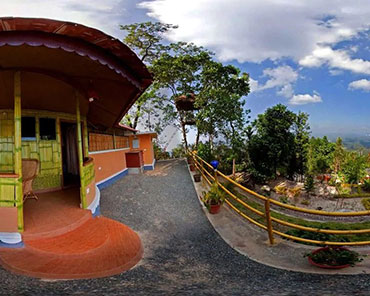In the digital age, technology continues to transform how we experience the world. One of the most exciting innovations is the advent of 360° virtual tours, which offer immersive and interactive ways to explore places from the comfort of your own home. From historical landmarks and natural wonders to bustling cityscapes and hidden gems, 360° virtual tours are revolutionizing travel, education, and real estate. In this blog, we'll dive into the fascinating world of 360° virtual tours, exploring their benefits, applications, and the technology behind them.
A 360° virtual tour is a digital representation of a location that allows viewers to explore the space as if they were physically present. Using panoramic images or video footage, these tours provide a fully immersive experience by letting users look around in any direction. The experience can be enhanced with interactive elements, such as clickable hotspots, informative text, and multimedia content.
Panoramic Views: Users can view a scene in all directions, offering a complete perspective of the location.
Interactive Elements: Clickable hotspots and information panels provide additional context and details about specific areas or objects.
Multimedia Integration: Videos, audio guides, and images can be embedded to enhance the experience and provide deeper insights.
Creating a 360° virtual tour involves several technological components:
360° Cameras: These specialized cameras capture panoramic images or video footage by using multiple lenses to cover the entire surroundings. Popular models include the Ricoh Theta, Insta360, and GoPro Max.
Stitching Software: After capturing images, stitching software combines them into a seamless 360° panorama. This process removes distortions and ensures a smooth, continuous view.
Virtual Tour Platforms: Platforms like Matterport, Kuula, and Pano2VR allow users to upload, edit, and publish their 360° content. These tools often offer features such as interactive hotspots and integration with other media.
Interactive Features: Adding clickable hotspots, informational text, and multimedia elements enhances the virtual tour and provides a richer user experience.
360° virtual tours have diverse applications across various fields:
Destination Marketing: Tourism boards and travel agencies use virtual tours to showcase destinations and attractions, allowing potential visitors to explore before booking.
Hotel and Accommodation: Hotels and resorts offer virtual tours of their rooms, amenities, and facilities to help travelers make informed decisions.
Property Showcases: Real estate agents use virtual tours to present properties to prospective buyers, providing a comprehensive view of homes and commercial spaces without the need for physical visits.
Remote Viewing: Buyers and renters can explore properties from anywhere in the world, making the process more convenient and efficient.
Educational Institutions: Schools and universities use virtual tours to give prospective students a virtual campus experience, helping them get a feel for the environment and facilities.
Corporate Training: Companies use virtual tours for training purposes, allowing employees to familiarize themselves with new workplaces or equipment.
Virtual Exhibits: Museums and cultural institutions create virtual tours of exhibits and historical sites, making art, history, and culture accessible to a global audience. Preservation: Virtual tours help preserve and document heritage sites, providing a digital record that can be referenced and studied.
Event Planning: Event organizers use virtual tours to showcase venues and spaces for weddings, conferences, and other events, helping clients visualize the setup and layout.
Virtual Events: For virtual or hybrid events, 360° tours can offer an immersive experience, allowing attendees to explore event spaces and interact with different elements.
Immersive Experience: Virtual tours provide a captivating and interactive experience, keeping users engaged and interested.
Increased Accessibility: Users can explore locations from anywhere in the world, breaking down geographical barriers and expanding reach.
Time-Saving: Virtual tours save time for both users and businesses by reducing the need for physical visits and streamlining decision-making processes.
Cost-Effective: For businesses, virtual tours can be a cost-effective marketing tool compared to traditional methods.
Informed Choices: Users can make more informed decisions by exploring detailed and interactive representations of properties, destinations, or products.
Stand Out: Virtual tours offer a modern and innovative way to market products, services, and destinations, helping brands stand out in a crowded marketplace.
As technology continues to advance, 360° virtual tours are likely to become even more immersive and sophisticated. Innovations such as virtual reality (VR), augmented reality (AR), and artificial intelligence (AI) could further enhance the experience, offering new ways to interact with and explore virtual environments.
Integration with VR and AR: Combining 360° tours with VR and AR technologies for even more immersive experiences.
AI-Powered Personalization: Using AI to personalize virtual tours based on user preferences and behavior.
Enhanced Interactivity: Developing more interactive and engaging elements, such as live guides and real-time interactions.
360° virtual tours are transforming how we explore and experience the world, offering an immersive and interactive way to discover new places, make informed decisions, and engage with diverse content. Whether you’re in the travel industry, real estate, education, or cultural preservation, incorporating virtual tours into your strategy can provide significant benefits and opportunities. Embrace the technology and start exploring the world virtually today!

 The Ultimate Guide to Search Engine Optimization (SEO)
The Ultimate Guide to Search Engine Optimization (SEO)
SEO is the process of optimizing your website to rank higher...
 The Synergy of Digital Marketing: A Modern Strategy for Success
The Synergy of Digital Marketing: A Modern Strategy for Success
Digital marketing encompasses a broad range of online strategies...
 Explore the World Virtually: The Rise of 360° Virtual Tours
Explore the World Virtually: The Rise of 360° Virtual Tours
A 360° virtual tour is a digital representation of a location that...